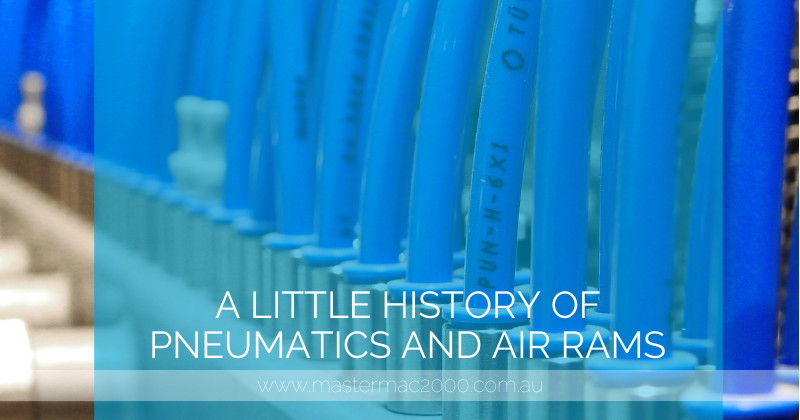A Little History of Pneumatics and Air Rams
 In mechanical engineering, pneumatics – sometimes called compressors or air rams – is the use of air pressure to create motion or some form of mechanical force. Pneumatics is mainly used in industries and factories where compressed air is a necessity. The compressed air is stored in one location and distributed through valves (hence the term pneumatic valves). Pneumatics is a cheaper solution to using actuators or electric motors because of the cheap availability of air. Compressed air can be stored and used even when there is a power outage.
In mechanical engineering, pneumatics – sometimes called compressors or air rams – is the use of air pressure to create motion or some form of mechanical force. Pneumatics is mainly used in industries and factories where compressed air is a necessity. The compressed air is stored in one location and distributed through valves (hence the term pneumatic valves). Pneumatics is a cheaper solution to using actuators or electric motors because of the cheap availability of air. Compressed air can be stored and used even when there is a power outage.
The design for anything that uses pneumatics is so simple and straightforward that it only utilises cylinders and pistons for moving parts.
First pneumatic tool in history
The first pneumatic tool in history was probably after metals were forged into weapons by blacksmiths who used bellows. The first modern air compressor was designed in the 1800s and was used in department stores. These compressors were also used on boats and barges; they had to be hand-operated, which needed four men to keep it going. Air pumps were also invented in the 1800s to supply air to divers using cumbersome diving suits that were not pressurised. Pneumatic steam engines also began to replace ships that used canvas sails.
Pneumatics in construction history
By the 19th century, pneumatics in the form of air compressors were widely used in heavy construction. Air compressors were used to dig the foundations of the Brooklyn Bridge. Compressors were also used in the building of bridges and dams in the 1920s and 30s when large volumes of water needed to be kept out.
Pneumatics today
In the pneumatics and air rams of the modern world, MasterMac2000 is the key Australian distributor for all types of pneumatic solutions for a diverse array of markets including industries involved in manufacturing, packaging, electrical power, food and beverage, and water sourcing. If your company requires pneumatics, get in touch today with MasterMac2000 by visiting their website at http://mastermac2000.com.au/.

About MasterMac2000: Your Trusted Pneumatic & Process Automation Partner.
LEADING THE INDUSTRY: Established in 1989, MasterMac2000 has grown to become one of Australia's largest privately owned pneumatic and process automation companies. We stock top-quality brands like Univer, Mack, Tolomatic, Mac, Piab, American, and Rotoflux in Brisbane.
SERVING QLD & NORTHERN NSW: We proudly service Queensland and Northern New South Wales for all your pneumatic and process equipment needs. Our mission is to provide the best pre and post-sales support while actively expanding our client base.
SOURCING HARD-TO-FIND PARTS: Not only do we stock quality components, but we also excel at sourcing those elusive, hard-to-find parts. With our extensive database and global network of contacts, getting the parts you require is as easy as a call to our highly skilled, professional sales team.
DEDICATED TO YOUR SUCCESS:
- Decades of expertise in pneumatics & process automation
- Carefully curated selection of world-class brands
- Exceptional sourcing capabilities for speciality parts
- Knowledgeable sales staff dedicated to finding solutions
- Unwavering commitment to customer service excellence
About The Author
Stuart Havill
Stuart Havill is the owner and manager of MasterMac2000, Queensland's largest privately owned pneumatic and process valve company.
With his early working career as a maintenance fitter for Boral in 1992, Stuart has spent his life in the field of pneumatics and process equipment. He gained extensive experience in plant design, maintenance, repairs, fabrication, and site management.
In 1996, he transitioned to a pneumatic sales technician role at MasterMac2000, where he excelled in key account management, providing cost-effective solutions, and managing a sales team of 9 employees.
Since 2002, Stuart has been the manager at MasterMac2000, overseeing the company's growth and establishing it as a leader in pneumatic automation and process valve engineering. His expertise spans customer training, CRM setup, industrial compressor sizing and installation, and turn-key project management.
Under Stuart's leadership, MasterMac2000 has been servicing the industry since 1988, with 5 full-time sales representatives covering northern rivers NSW, Queensland, Northern Territory, and PNG. The company prides itself on providing the best-priced solutions to all customers in the marketplace.
View Stuart’s LinkedIn profile to learn more about his expertise in pneumatics and process equipment.